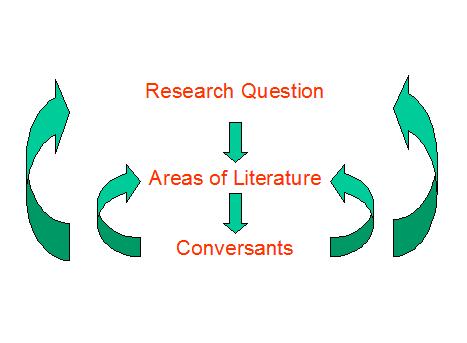Drawing your map
is
of course the start, rather than the end of the process. By making
your
positioning more explicit you raise questions concerning the content
of
the circles and also the nature of the overlaps. These suggest
further
exploration, which then refine and reposition the circles. To begin
with, a piece of research often will have very broad definitions in
the
circles such as ‘organization theory’ ‘marketing’ ‘strategy’ etc. As
the
literature gets refined these become more precise such as
‘organizational boundaries’; ‘buyer-seller dyads’; ’resource based
view
of strategy’ etc. Therefore the map should be seen as a particular
record of your thinking at a point in time rather than a template to
stick within. Maps develop as the domains are explored in more
detail.
This is illustrated in Figure 5.
Figure 5: The dynamics of
literature maps

Typically, a piece of research starts with a question which requires you to review domains of literature that inform this question. However, as the literature is explored and conversants are identified this brings out new domains of literature and these may then cause the research question to be modified. In turn this requires new areas of literature to be identified. For example, in our alliances study as we explore the area we may find that the work on national cultures and cultural sensitivity becomes more important, and instead of looking more generally at alliances so the focus shifts to the way in which cultural understanding is used to improve the effectiveness of alliances. Whilst it means that we now need to introduce a further circle or literature domain, this is a more specific issue and one which becomes more researchable and with a clearer contribution. The mapping process is therefore one of continual monitoring and review to make sure that all the areas of literature are informed by and contribute to the research question.
In order to ensure consistency with this
process
you should always consider both the research question and the map
together. By looking at the two you can establish whether there is a
consistency between your question and the areas of literature. For
example, if we return to the research on alliances, MNCs and
developing
countries let us state the research question as follows: “How do
MNCs
form alliances in developing countries?” The phenomena is the
formation
of alliances by MNCs. The context is developing countries. However
if we
now revise the research question as follows: “How do developing
countries support the fomation of alliances by MNCs ?” Here we have
moved the terms around and the phenomena has become government
support
of alliances. This subtle shift in the question has completely
revised
the focus of the research and one would expect that the map of the
second research question to have a domain relating to government
policy
and relationships with MNCs as this now becomes the central
phenomena.
The text on this page was reproduced with permission from Professor Mark Jenkins, Cranfield School of Management. The ideas are based on teaching sessions with PhD and DBA students at Cranfield School of Management, and draw from ideas on writing developed by Anne Huff.
|
|
|


